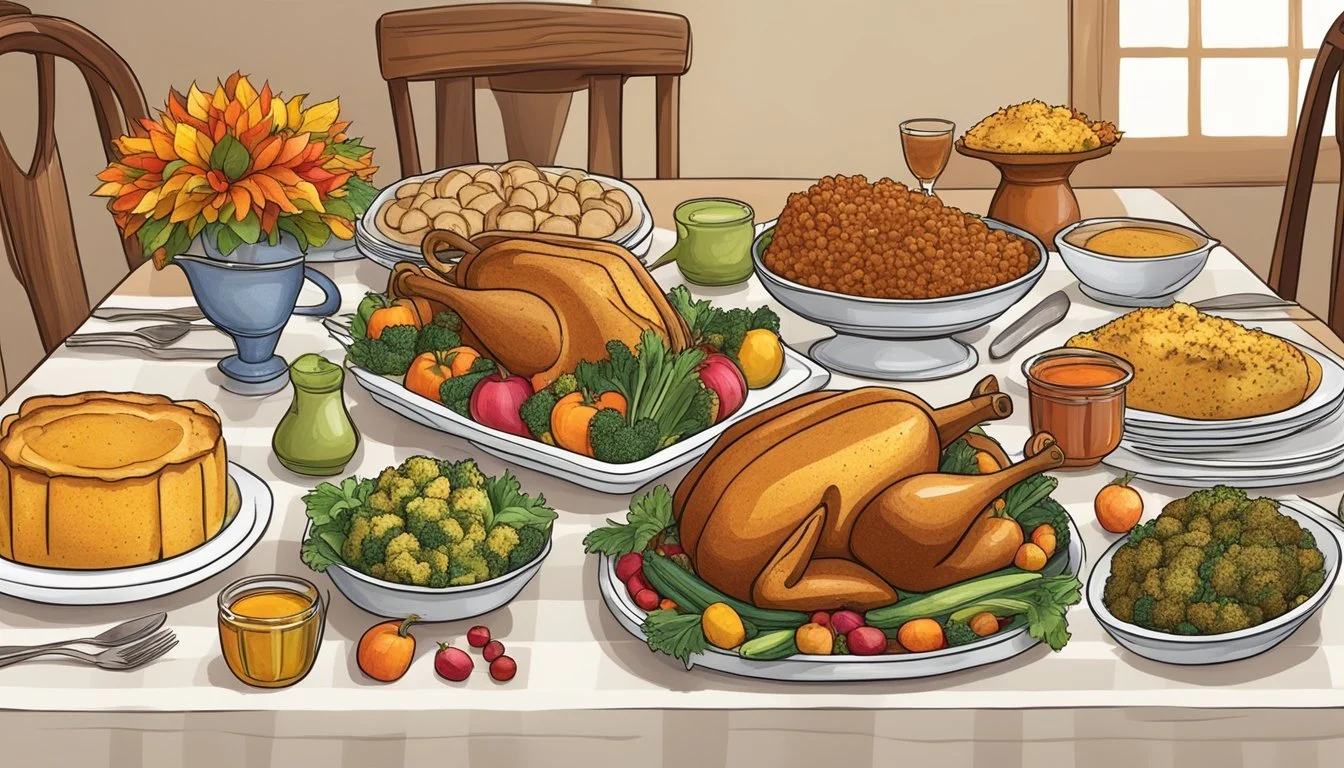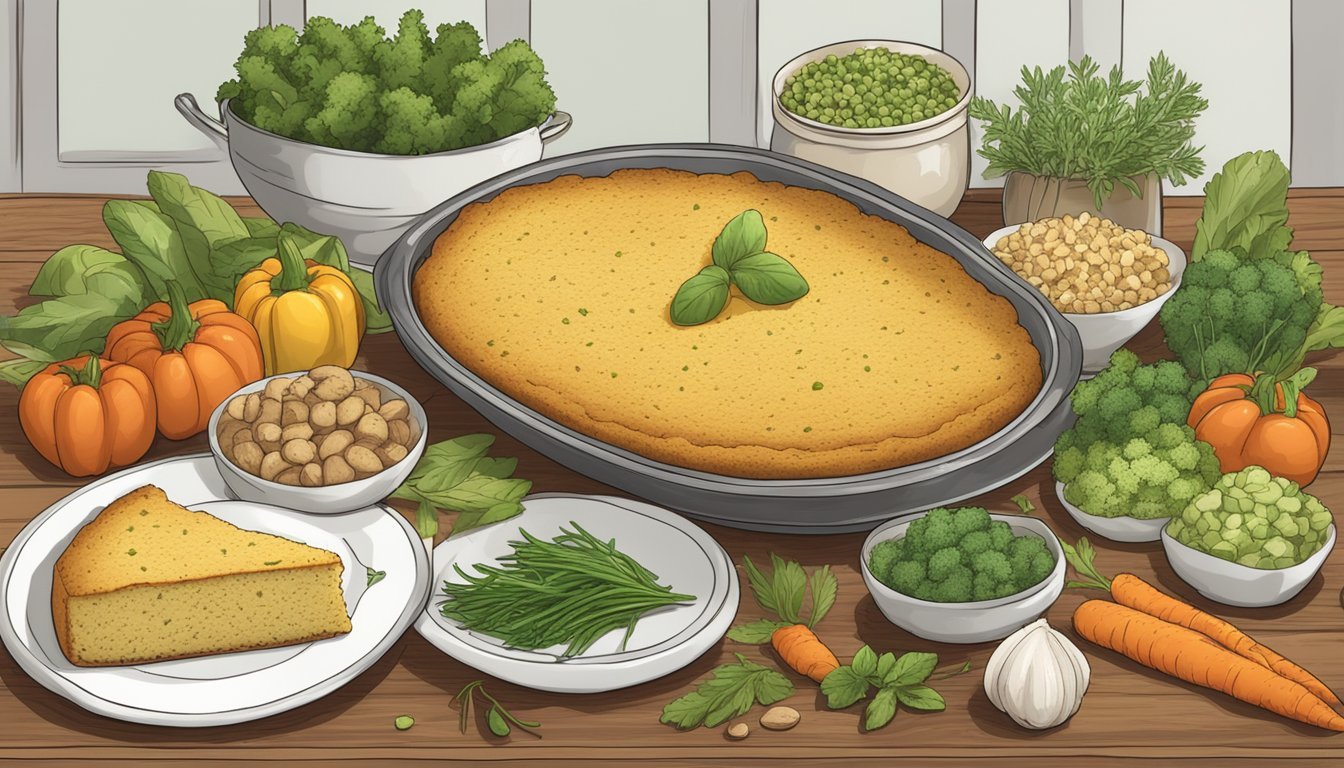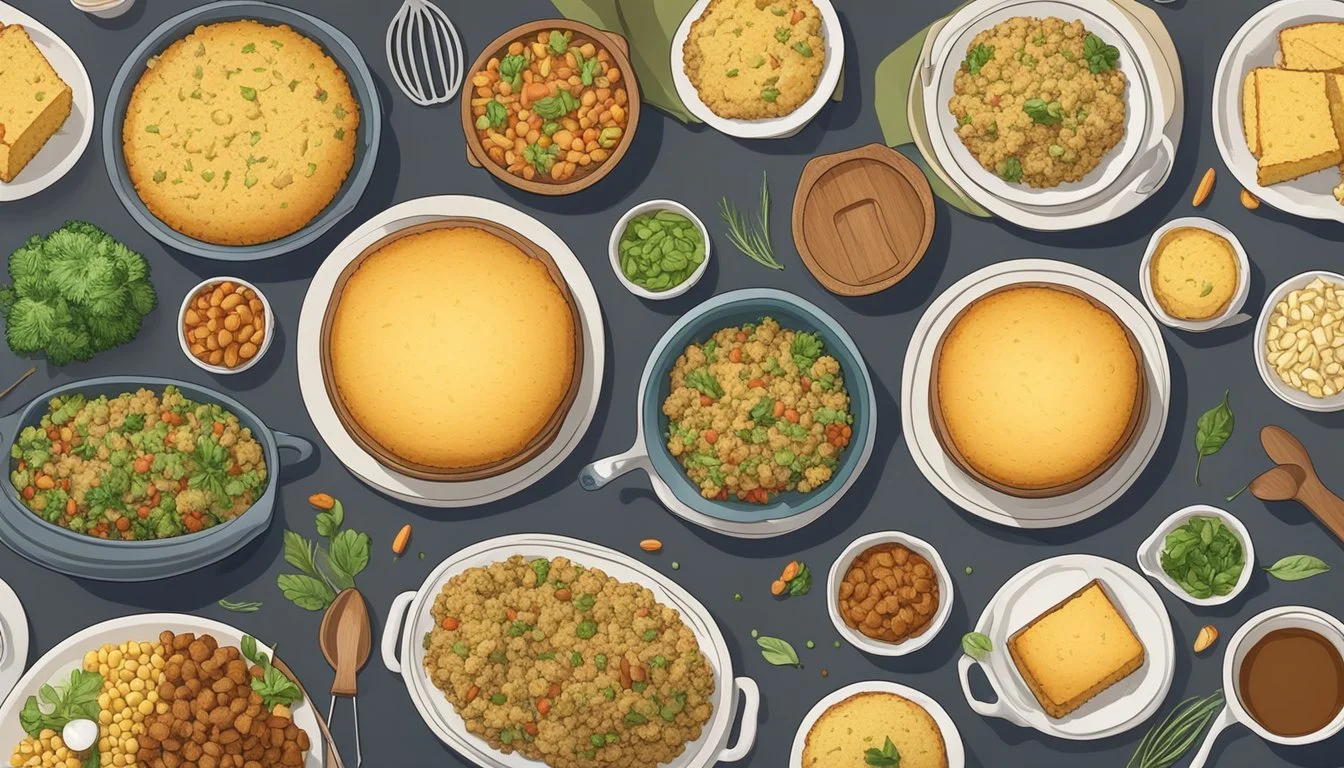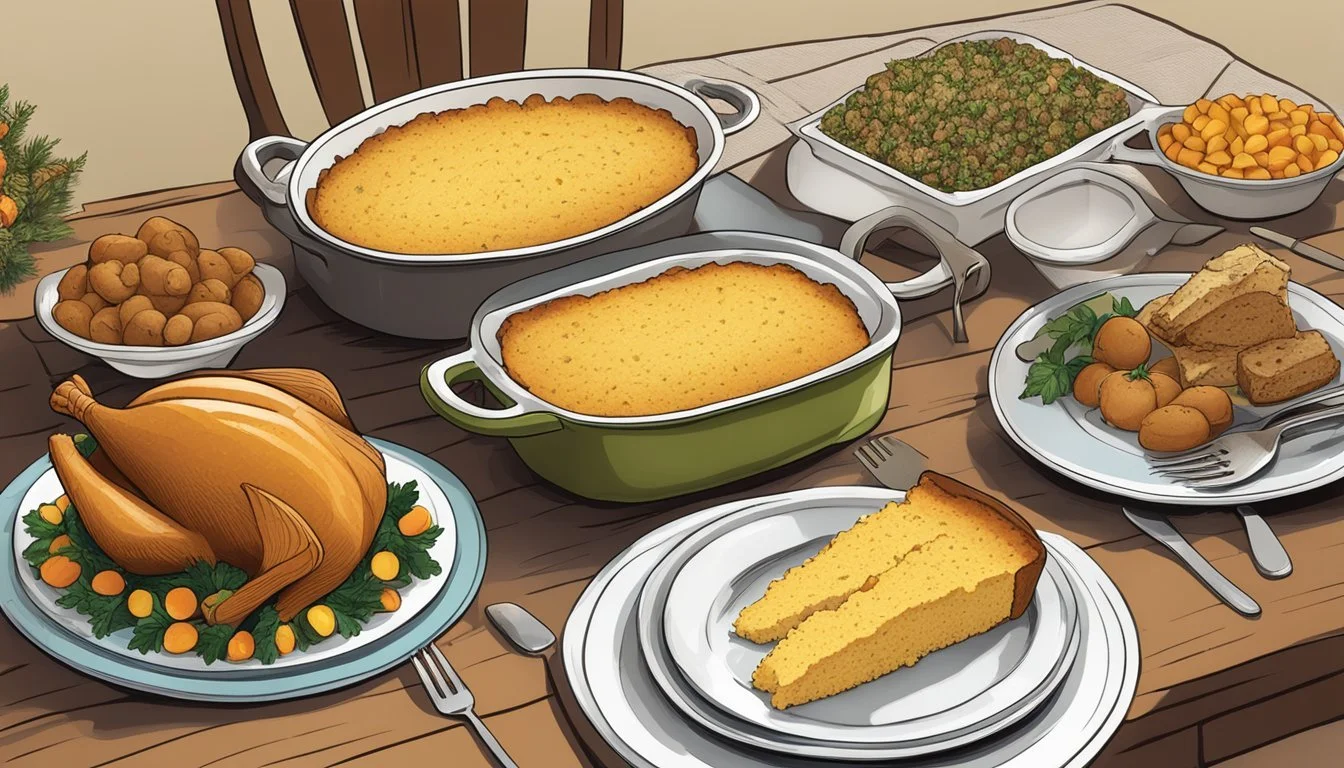Is Cornbread Stuffing Gluten-Free?
Unveiling the Truth About This Classic Side Dish
Cornbread stuffing, a staple at many dinner tables during festive seasons, typically contains gluten due to the nature of the cornbread itself, which is often made with wheat flour as a binding agent. However, with the rise of gluten sensitivity and celiac disease, many people are looking for gluten-free alternatives to traditional recipes. Gluten-free cornbread stuffing is indeed possible and can be just as flavorful and satisfying as its traditional counterpart.
Creating a gluten-free version involves using cornmeal and alternative flours such as almond or rice flour that do not contain gluten. For the stuffing, it's important to prepare the cornbread from scratch to ensure no cross-contamination with gluten-containing ingredients. Many home cooks and commercial food producers alike have embraced gluten-free cornbread stuffing, offering a variety of recipes and pre-made options that cater to those avoiding gluten.
When selecting ingredients for gluten-free cornbread stuffing, it is critical to read labels carefully to ensure that all components, including the cornmeal, are certified gluten-free. Spices, broth, and additional ingredients like onions (What wine goes well with onions?) and celery can be safely incorporated into gluten-free stuffing as they naturally do not contain gluten. This attention to detail ensures that the dish remains safe for individuals with gluten intolerances while still capturing the essence and tradition of the beloved cornbread stuffing.
Understanding Gluten in Cornbread Stuffing
When exploring whether cornbread stuffing is gluten-free, it's crucial to understand what gluten is and its presence in traditional cornbread recipes. Identifying the right ingredients, such as gluten-free cornmeal and flour blends, is key to creating a gluten-free version.
What Is Gluten?
Gluten is a protein found in certain grains, such as wheat, barley, and rye. It acts as a binding agent, providing elasticity and helping foods maintain their shape. For individuals with celiac disease or gluten sensitivity, consuming gluten can lead to severe health reactions, necessitating gluten-free dietary choices.
Gluten in Traditional Cornbread
Traditional cornbread typically includes ingredients that contain gluten. Standard recipes call for all-purpose flour, which is derived from wheat and is a primary source of gluten. Therefore, typical cornbread is not safe for those following a gluten-free diet.
Traditional Cornbread Ingredients:
All-purpose flour (contains gluten)
Cornmeal
Baking powder
Salt
Eggs
Milk
Butter
Identifying Gluten-Free Cornmeal
Not all cornmeal is created equal. While corn is naturally gluten-free, cross-contamination with gluten-containing grains can occur during processing. One must ensure that the cornmeal is labeled as gluten-free, confirming that it has been processed in a facility free of gluten contamination.
Traits of Gluten-Free Cornmeal:
Labeled "gluten-free"
Processed in a dedicated gluten-free facility
Using gluten-free cornmeal and substituting traditional flour with a gluten-free flour blend are essential steps in creating gluten-free cornbread. These flour blends often include a mix of rice flour, tapioca starch, and xanthan gum, which mimic the texture and binding qualities of gluten, without the associated health risks for those with sensitivities.
Gluten-Free Cornbread Stuffing Basics
Creating gluten-free cornbread stuffing involves selecting the right gluten-free ingredients, using alternative flours, and following a recipe that ensures the final dish is safe for those with gluten sensitivities.
Selecting Gluten-Free Ingredients
To guarantee that cornbread stuffing is gluten-free, the selection of ingredients is crucial. One must ensure that each ingredient, including baking powder and baking soda, is labeled gluten-free, as these can sometimes contain gluten. For the stuffing, traditional wheat-based bread should be substituted with homemade or store-bought gluten-free cornbread, and cross-contamination with gluten-containing products must be avoided during preparation.
Alternative Flours for Gluten-Free Cornbread
Gluten-free cornbread forms the basis of the stuffing and can be made using a variety of gluten-free flours. Options include:
Almond flour: which adds a rich, nutty flavor.
Rice flour: a neutral choice that mimics the texture of traditional wheat flour.
Coconut flour: which provides a slightly sweet taste and is highly absorbent, meaning it requires more liquid.
A successful gluten-free cornbread recipe typically combines these flours with cornmeal to achieve the right texture and flavor.
Gluten-Free Cornbread Stuffing Recipe
For gluten-free cornbread stuffing, the process begins by baking the gluten-free cornbread. Once baked and cooled, it is then cut into cubes and combined with sautéed vegetables like onion and celery. Here is a brief outline of the recipe process:
Bake the cornbread: Use the selected gluten-free flour blend to bake the cornbread at the recommended temperature, which is usually around 350°F to 400°F, checking that it is cooked through.
Prepare the stuffing: In a skillet, sauté the vegetables in olive oil or gluten-free butter until tender.
Combine and bake: Mix the sautéed vegetables with the cubed cornbread, add herbs and seasoning, and bake until the top is golden brown, typically for 20 to 25 minutes at 350°F.
This simple approach results in delicious gluten-free stuffing, perfect for any gathering or meal requiring a gluten-free option.
Preparation and Baking Techniques
When creating gluten-free cornbread stuffing, attention to detail in preparation and baking techniques ensures that the dish is delicious and safe for those with gluten sensitivities. It is important to use gluten-free ingredients from start to finish.
Cooking Gluten-Free Cornbread
One starts by selecting a gluten-free baking mix or a blend of gluten-free flours such as rice, sorghum, or almond flour to make the cornbread base. A typical recipe will involve combining the gluten-free flour with cornmeal, sugar, baking powder, and salt. Wet ingredients typically include milk (dairy or non-dairy alternatives), eggs, and oil or melted butter. They should then preheat the oven to 400 degrees Fahrenheit and grease a 10-inch skillet or a 9x9-inch baking pan with nonstick cooking spray before baking the cornbread mixture. The cook time usually ranges between 20 to 25 minutes until the cornbread is golden and cooked through.
Preparing Stuffing Mixture
Once the cornbread is cooled, it needs to be crumbled or diced into small pieces. These pieces are then mixed with additional ingredients, which might include sautéed onions and celery, herbs, and seasonings. For additional moisture, one could add stock or broth, ensuring it's gluten-free. The prep time for the mixture is minimal, often taking just as long as it takes to sauté the vegetables, which is usually around 10 to 15 minutes.
Baking Gluten-Free Stuffing
The oven should be preheated to 350 degrees Fahrenheit. The stuffing mixture is then transferred into a greased casserole dish or baking dish. For even baking, they should spread the mixture out evenly. If one wishes to avoid the stuffing drying out, they may cover the dish with foil. The bake time for the stuffing varies, but it generally takes around 20 to 30 minutes. For a crispier topping, they can remove the foil during the last 10 minutes of baking. It's essential to ensure that the stuffing reaches the proper internal temperature for safe consumption before serving.
Flavor Enhancements and Variations
Crafting the perfect gluten-free cornbread stuffing involves selecting the right blend of herbs, spices, and add-ins. The following subsections suggest specific enhancements to elevate the base recipe.
Herbs and Spices for Stuffing
Fresh herbs typically impart a more vibrant flavor to stuffing than their dried counterparts. Key herbs include:
Sage: A traditional stuffing herb with a robust, earthy flavor.
Rosemary: It provides a pine-like aroma and woodsy taste.
Thyme: Offers a subtle, slightly minty flavor.
In contrast, dried herbs are more concentrated and should be used in smaller quantities. For example, if a recipe calls for one tablespoon of fresh thyme, one should use just one teaspoon of dried thyme.
Incorporating Vegetables
Vegetables not only add flavor but also texture and color to stuffing. Two staples are:
Onion: Provides a sweet yet sharp bite.
Celery: Adds a crisp, refreshing crunch.
Sautéing these vegetables before adding them to the stuffing will enhance their flavors, mellowing the sharper notes of onion and garlic, and making them more complementary to the cornbread base.
Gluten-Free Add-Ins
Exploring gluten-free add-ins can introduce new textures and flavors. Consider incorporating:
Gluten-Free Sausage: Ensure it's labeled as gluten-free.
Roasted Nuts: For a crunchy texture contrast.
When selecting add-ins, one must always verify their gluten-free status to maintain the integrity of the stuffing.
Serving and Pairing Suggestions
Cornbread stuffing is a versatile dish that can be served with a range of traditional side dishes and proteins. It is especially popular during Thanksgiving as a key side dish but can be enjoyed year-round with various courses to complement its hearty flavor.
Traditional Side Dishes
Green Bean Casserole: A classic Thanksgiving side, the creamy texture and savory taste pairs well with the slightly sweet cornbread stuffing.
Cranberry Sauce: The tartness of cranberry sauce provides a delightful contrast to the rich and savory stuffing.
Sweet Potato Casserole: Its natural sweetness and soft texture create a perfect balance with the denser stuffing.
Pumpkin Pie: As a dessert, pumpkin pie rounds off the meal, complementing the spice notes commonly found in cornbread stuffing.
Recommended Gluten-Free Proteins
Turkey (What wine goes well with turkey?): The quintessential Thanksgiving protein, turkey's mild flavor and tender meat make it an ideal companion for the robust stuffing.
Ham: For a sweeter option, ham lends a smoky-sweet dynamic to the meal when served with gluten-free cornbread stuffing.
Servings of these dishes should be adjusted to cater to the number of guests and the serving sizes of the main protein to ensure a balanced meal.
Storage and Reheating Tips
Proper storage and reheating techniques ensure that leftover cornbread stuffing retains its quality and texture. Below are specific tips to store and reheat your stuffing, maintaining its flavor and safeguarding against foodborne illnesses.
Storing Leftover Stuffing
Leftover cornbread stuffing should be stored in an airtight container to prevent it from drying out. It can be kept in the refrigerator for up to four days. For longer storage, one can freeze the stuffing:
Refrigerate within two hours of cooking to preserve freshness.
In the Fridge: Place in an airtight container; consume within 3-4 days.
To Freeze: Wrap tightly with foil or plastic wrap, then place in a freezer bag. Freeze for up to one month for best quality.
How to Reheat for Best Texture
Reheating cornbread stuffing correctly is crucial for restoring its original flavor and texture.
In the Oven: Preheat the oven to 350°F. Transfer stuffing to an oven-safe dish and add a splash of broth or water to prevent dryness. Cover with foil and reheat for about 30 minutes, or until thoroughly warmed.
In the Microwave: For smaller portions, use a microwave-safe dish. Cover with a damp paper towel and reheat on a medium power setting, checking frequently to avoid overheating.
Special Dietary Considerations
When adapting cornbread stuffing to be gluten-free, it's vital to consider additional dietary needs, such as dairy-free or vegetarian preferences, as well as managing caloric intake.
Dairy-Free and Vegetarian Options
A dairy-free gluten-free cornbread stuffing can be accomplished by using alternatives such as almond milk or other plant-based milks, and by substituting butter with plant-based oils or margarines. For vegetarian stuffing, ensure the use of vegetable broth instead of traditional chicken stock. Here are the specific substitutes:
Milk: Use almond, soy, or coconut milk.
Butter: Opt for olive oil, coconut oil, or dairy-free margarine.
Managing Calories in Gluten-Free Stuffing
Gluten-free cornbread stuffing can have high caloric content, primarily owing to ingredients like butter and cornmeal. To manage calories in gluten-free stuffing:
Reduce butter/oil: Use less than the recipe calls for, or replace some with apple sauce if it doesn't compromise the integrity of the recipe.
Broth: Choose a low-calorie vegetable broth to moisten the stuffing.
By focusing on these ingredients and making careful replacements, one can create a stuffing that's inclusive of various dietary restrictions without compromising on flavor.
Advanced Preparation Strategies
Properly preparing cornbread stuffing in advance can significantly streamline the cooking process, especially during busy holiday seasons. These strategies focus on time-saving methods without compromising the quality of the final dish.
Making Cornbread Stuffing in Advance
Preparing cornbread stuffing ahead of time can save on the total time required on the day of your meal. One can make the cornbread up to two days prior, allowing for it to dry out slightly, which is optimal for stuffing. The dry ingredients can be mixed and stored separately, and wet ingredients combined and refrigerated. Assembling the stuffing just before baking ensures freshness and prevents sogginess.
Freezing and Thawing Methods
Cornbread stuffing can be prepared and frozen to facilitate make-ahead convenience. For the best results, one should:
Freeze: Assemble the stuffing mixture and transfer it to a freezer-safe container. It can be frozen for up to three months, retaining its quality.
Thaw: To thaw, one should ideally transfer the stuffing from the freezer to the refrigerator overnight, ensuring it thaws completely and evenly.
Bake: After thawing, the mixture should be baked in a preheated oven at 350°F until it's heated through and the top is golden-brown.
Freezing and thawing methods not only manage meal preparation time more efficiently but also lock in the freshness and flavors of the ingredients when done correctly.
Troubleshooting Common Issues
When preparing gluten-free cornbread stuffing, two primary issues often arise: dryness in the stuffing and imbalances in flavor or texture. Addressing these effectively can enhance the stuffing's overall appeal.
Dealing with Stuffing Dryness
The key to a moist stuffing lies in the use of liquids and fat. If the stuffing is too dry, it may need more broth or melted butter. Consider the following:
Liquid Ratio: The stuffing should be moist but not soggy. If it's dry, gradually add more chicken broth or vegetable broth, about a quarter cup at a time, until the desired texture is reached.
Cover While Baking: Cover the stuffing with foil during the first half of baking to retain moisture. Uncover in the last minutes to allow for a crispy top if desired.
Balancing Flavors and Textures
Balancing the elements is essential for a satisfying stuffing. Here are ways to achieve that balance:
Sautéed Vegetables: Sautéing onions and other vegetables in butter before adding them to the stuffing will enhance the flavor. A nice golden color on the onions indicates that they are ready.
Seasoning: Adjust seasoning with salt and black pepper to taste. Fresh herbs can also add dimension.
Cornbread Preparation: If the cornbread is cubed, ensure it's not overly crumbled, as this can affect texture. Letting the cornbread sit for a day before making the stuffing can improve the texture.
Use these strategies to troubleshoot common issues, and the gluten-free cornbread stuffing will be a savory complement to any meal.
Exploring Cultural Variations
The cultural significance of cornbread stuffing varies remarkably across different traditions, primarily seen in American Thanksgiving customs and its adaptation within various cuisines.
American Thanksgiving Traditions
Cornbread stuffing is a quintessential dish at American Thanksgiving tables, reflecting the holiday's historical and cultural essence. This version of stuffing, also known as dressing, often includes a blend of crumbled cornbread, herbs, and vegetables such as onions and celery. In some regions, additions like sausage or oysters impart a distinct local flavor. Thanksgiving celebrates the harvest and other blessings of the past year, and the inclusion of cornbread stuffing pays homage to traditional ingredients native to the Americas.
Cornbread Stuffing in Different Cuisines
Cornbread stuffing, while traditionally linked to Thanksgiving, has found its way into Christmas and other holiday feasts around the world. Each cuisine might reinterpret this dish to align with local ingredients and flavor profiles. Here is how cornbread stuffing diversifies across different cultures:
Southern United States: It is common to moisten the stuffing with rich stocks, integrating ingredients like pecans or pork for a heartier dish.
Southwestern United States: They might incorporate elements like chilies or corn kernels to reflect regional tastes.
Non-American Cuisines: Globally, cooks might replace traditional add-ins with local staples such as chorizo in Spanish-influenced regions or chestnuts in parts of Europe.
Cornbread dressing goes beyond a mere side dish; it represents a culinary canvas that adapts and respects the cultural palate of each region or holiday celebration.











